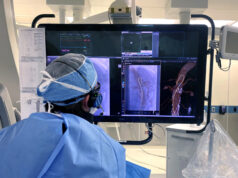
A study presented at the 2016 European Society of Cardiology (ESC) congress (27–31 August, Rome, Italy) indicates that functional imaging—using cardiac magnetic resonance (MR) and myocardial perfusion scintigraphy (MPS)—is associated with significantly reduced rates of unnecessary angiography than is guideline-directed care.
In the CE-MARC 2 (Clinical evaluation of MRI in coronary heart disease 2) trial, which has also been published in the Journal of the American Medical Association, John Greenwood (University of Leeds, Leeds, UK) and colleagues randomised 1,202 patients with suspected coronary artery disease to functional imaging-based investigations—with either cardiac MR (481) or MPS (481)—or to guideline-directed investigation (n=240) based on National Institute for Health and Care Excellence (NICE) recommendations.
In the guideline-directed investigation group, patients with a pre-test likelihood of 10%–29% (based on age, gender, symptom characteristics, and clinical history) were scheduled for cardiac computed tomography (CT), those with a pre-test likelihood of 30%–60% (intermediate risk) were scheduled for MPS, and those with a high pre-test likelihood were sent directly to coronary angiography. The primary endpoint of the study was unnecessary coronary angiography within 12 months, (defined by absence of significant stenosis measured by fractional flow reserve or quantitative coronary angiography), with secondary endpoints of major adverse cardiovascular events (MACE), and positive angiography within this same time period.
By 12 months, overall, 22% of the study population had undergone coronary angiography—with unnecessary angiograms occurring significantly more frequently in the guideline-directed group: 28.8% vs. 7.5% for the cardiac MR group and 7.1% for the MPS group. Additionally, the adjusted odds ratio of unnecessary angiography for the cardiac MR group vs. the guidelines group was 0.21 (95% CI, 0.12-0.34; p<0.001), with no statistically significant difference between the cardiac MR and MPS groups. Between the three strategies, there was no difference in short-term MACE or positive angiography rates.
Greenwood, who presented the data the ESC, commented: “Rates of invasive angiography are considered too high among patients with suspected coronary artery disease. Our findings show that both cardiac MR and MPS significantly reduced rates of unnecessary angiography compared to guideline-directed care, with no penalty in terms of MACE. This suggests that functional imaging should be adopted on a wider basis, even in high-risk patient subgroups.”
He concluded that “these results show that a broader use of functional imaging (cardiac MR or MPS), in low-, intermediate- and high-risk patient groups, could reduce the rates of invasive angiography that ultimately show no obstructive coronary disease.”












